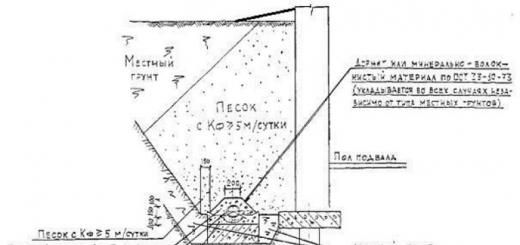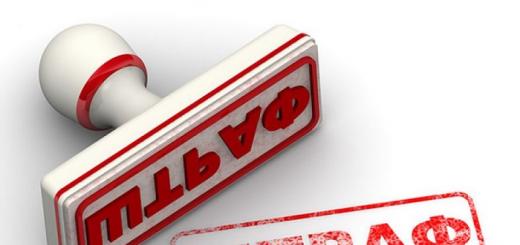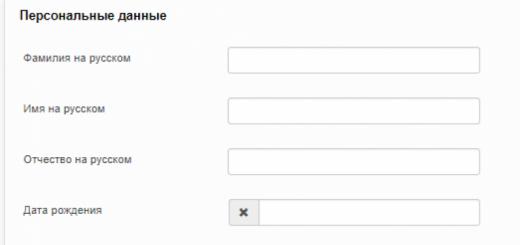The article contains comprehensive information on what is a tax deduction for children in 2020: application form, how much deduction per child, deduction limit, deduction codes per child, double deduction in favor of one of the parents who is eligible for this type standard tax deductions How to take advantage of child tax credits.
Tax deduction for children: what is it and who is eligible for the deduction in 2020
Procedure and amount of provision tax deduction for children are regulated by Article 218 of the Tax Code of the Russian Federation. Detailed information you can read about what it is in the corresponding article. In relation to deductions for a child, this is the amount from which 13% of income tax (PIT) is not withheld.
Important! If the spouses have a child from previous marriages, then the common baby will be considered the third.
The 2020 standard child tax credit is for each child:
- under the age of 18;
- for each full-time student, graduate student, intern, student, cadet under the age of 24 (the refund amount is not more than 12,000 rubles).
The right to a refund is lost in the following cases:
- adulthood (or graduation from an educational institution after the age of 24);
- official marriage of the child;
- his death.
Amounts and deduction codes for children in 2020
The deduction for children is valid until the month in which the taxpayer's income, calculated on an accrual basis from the beginning tax period(new year) exceeded 350,000 rubles.
- For the first child (code 114) is 1,400 rubles;
- For the second child (code 115) - 1,400 rubles;
- For the third child (code 116) and subsequent ones - 3,000 rubles;
- For a disabled child in 2020 (code 117) - 12,000 rubles for parents and adoptive parents and 6,000 rubles for guardians, trustees and adoptive parents.
Please note that the indicated amounts in rubles are not the amount that you can return, but the amount from which 13% tax is not withheld. For example, if a citizen of the Russian Federation has three children under the age of 18, the amount of the benefit for him will be (1,400 + 1,400 + 3,000) * 0.13 = 754 rubles. monthly.
In the same amount, the second parent (guardian) has the right to receive a deduction at the same time if he has taxable income.
Let's look at an example:
In January 2020, Ivanova's salary was 35 thousand rubles. If there are two healthy minor children, she is entitled to a deduction in the amount of 2.8 thousand rubles. (1.4 thousand rubles for each child).
From the January salary of Ivanova, 13% of personal income tax will be withheld 4186 rubles. Calculated using the following formula: 35,000 (salary) minus 2,800 (tax deduction) * 13%.
If Ivanova did not have children, then 13% would be withheld from the full salary: 35,000 * 13% \u003d 4,550 rubles.
Thus, it was possible to save 364 rubles.
Required Documents to Claim Child Tax Credit
Usually, the employer submits the necessary data to tax service to issue a deduction for the children of an employee. In this case, no tax will be withheld from these amounts, and in order to receive a tax deduction for children in 2020, you must provide the employer with the following documents:
Important! If the applicant works officially in several places, then the benefit is provided only with one employer.
FAQ on applying for a standard tax deduction for children in 2020:
The employer has the right to provide a deduction for the child from the beginning of the year, regardless of the month in which the application for its receipt was submitted and all the necessary documents were collected.
The amount of tax deductions should be determined based on the total number of children of the taxpayer, including those for whom tax deductions are not provided. This applies not only to natural children, but also those in guardianship or care, adopted children, stepdaughters and stepchildren.
Important! When calculating the average per capita income for each family member, for example, to receive benefits for the firstborn, income is taken into account in its entirety (before the tax deduction is applied).
If the parents are divorced or in a civil marriage
If there is no marriage between the parents of the child, then it is possible for the second parent to receive a deduction upon providing a document confirming that the child is on the taxpayer's support. For example, it could be:
- certificate of registration of the child at the place of residence of this parent;
- notarial agreement of parents on the payment of alimony;
- a copy of the court decision, which contains an explanation of who the child lives with.
Double child allowance for single parent
The legislation does not define the concept of “single parent”, however, as the Ministry of Finance notes, the parent is not the only one if the marriage between the parents of the child is not registered. The absence of the second parent of the child can be confirmed by one of the following documents:
- birth certificate, which lists one parent;
- certificate of the registry office that the second parent is entered in the birth certificate according to the mother (form 25);
- death certificate of the other parent;
- a court decision declaring the other parent missing.
Nuances of calculus and registration
The tax deduction for a disabled child in 2020 is cumulative. This means that parents can standard deduction for disability (from 6 to 12,000 rubles) plus a child deduction, depending on how the child with disabilities appeared in the family - first, second, third or subsequent. Thus, the amount of the deduction increases by 1.4 to 3 thousand rubles.
Important! If a child has a disability group 1 or 2, then parents can receive benefits until their son or daughter turns 24 (with group 3 - up to 18 years).
The deduction is made directly from the employer. But in the event that the employer fails to provide the deduction or provides it in a smaller amount than it should be, the taxpayer has the right to independently apply to tax authority for registration (recalculation) of payments.
It is important to recall the following nuances.
- The last 12 months are taken for calculation, but if the employee did not find a job at the beginning of the year, then his taxable income from the previous place of work is taken into account.
- If the tax was partially withheld from the payment received, then only the part from which tax deductions were made is taken. So, when issuing financial assistance in the amount of 10 thousand rubles, only 6 thousand are subject to personal income tax, so for the calculation you should take not ten, but six thousand.
- With an internal combination, the total income for all positions is considered, with an external one - only income for the main place of work.
- If the income exceeded the allowable limit of 350 thousand, this is an excellent reason to refuse in favor of the other parent.
The government has several innovations in the future, but whether they will be implemented is still unknown:
- a tenfold increase in the maximum tax deduction by 10 times for large families;
- with a salary of less than 30 thousand rubles. – full exemption from personal income tax
The amount of the tax deduction for children in 2020 can range from 1400 to 12 thousand rubles, depending on the health of the child and his order of appearance in the family. And although about 2 years ago the deputies wanted to consider additional benefits for the standard tax refund for large and low-income families, the issue is still in limbo.
28.03.17 476 524 6
How to save on income tax
I have two children, and for this the state gives my husband and I a discount when paying personal income tax.
Thanks to children, every year we give the state 5,000 rubles less.
Chances are you get the standard child tax deduction too. When you get a job, the accounting department asks you to bring a copy of the child's birth certificate and write an application for a deduction. Then the employer acts on his own: every month he deducts the amount of the deduction from your salary and pays 13% personal income tax from the remaining amount. If this was not the case, do not worry: the deduction can be returned for the last three years.

Elena Glubko
receives a deduction for two children
Who is entitled to a deduction
If you work and pay personal income tax from your salary, you have the right to receive a child deduction from the month in which the child was born. But they will give it to only one place of work, even if you work part-time for several employers.
The state does not give a deduction for all income, but only for those from which you or your employer pays personal income tax. If you are an individual entrepreneur on a simplified system, patent or imputation and do not pay personal income tax from your income, you will not be given a deduction. But an individual entrepreneur on the general taxation system will receive a deduction, because he gives 13% of his profits to the state.
You will receive a child deduction even if you rent out an apartment, car or other property. To do this, you need to submit a 3-NDFL declaration to the tax office, in which you indicate the annual income received and claim the right to deduct.

How much will I save
The amount of the deduction depends on the number of children: the more children, the lower the tax, and both parents can receive the deduction.
The first and second child are exempt from the tax for 1400 rubles. Thus, every month I save 364 rubles. The husband saves the same amount from his salary.
The third and each subsequent child exempts another 3,000 rubles a month from the tax. If the spouses have a child from previous marriages, then their common child will be the third. A common child saves both parents 390 rubles each month, and children from previous marriages - 182 rubles each.
Victor and Maria have one child each from previous marriages and one common. Victor pays alimony for his first child, brings up his stepdaughter and a son in common with his new wife. Viktor will receive a 1,400 ruble deduction for his first child, 1,400 rubles for his stepdaughter, and 3,000 rubles for his son, and will save 754 rubles on taxes. His new wife will receive 1,400 rubles of deduction for her daughter and 3,000 rubles for her son, and will save 572 rubles.
Therefore, the common child of Maria and Victor will be the third and they will give him a 3,000 ruble deduction
Victor's new wife has only two children, but for the second she will receive a deduction as for the third. The Ministry of Finance sums up the children of both parents, so the common child of Maria and Victor will be the third and they will give him a deduction of 3,000 rubles:
Thus, not only parents can receive the deduction, but also stepmother, stepfather, guardians, adoptive parents, trustees and divorced parents, if they financially support the child.
We're not just talking about deductions.
But also about how to maintain a joint budget, teach a child to save, raise his salary and invest money profitably
The deduction will be given to you until the child is 18 years old. Moreover, if the child turns 18 at the beginning of the year, your right to the deduction will not expire on his birthday, but will remain valid until the end of the year. For children who continue their full-time studies for a fee or free of charge, the deduction will be extended for the entire period of study - up to a maximum of 24 years. For example, if in June the child graduated from the university and received a diploma, then from July you will no longer receive a deduction for him.
If the deduction is no longer given for older children, they are still taken into account when providing a deduction for younger brothers and sisters. If you have, for example, three children, and the older two have grown up a long time ago and you don’t receive anything for them, the deduction for the third child will still remain 3,000 rubles:
For disabled children, the deduction is higher: 12,000 rubles for parents and 6,000 rubles for guardians and trustees. This deduction is cumulative with the regular child deduction. For example, if a disabled child was born first or second, each parent will receive two deductions: 1,400 and 12,000 rubles, and save 1,742 rubles. If the child is the third in the family, 3,000 and 12,000 rubles will be exempted from the tax - parents will save 1,950 rubles each.
With the help of deductions, the state seeks to support people with low salaries, so it has set an annual limit. To stretch the deduction for the whole year, you need to receive no more than 29,166 rubles per month. If you receive 50,000 rubles a month, then in August your income will exceed 350 thousand and there will be no deduction. From August until the end of the year, you will pay personal income tax on your entire salary.
350 000 R is maximum amount annual income for which you are entitled to a deduction
It happens that there is no salary for several months: during a crisis, an employee was sent on vacation at his own expense or he took sick leave. In this case, the deduction for these months does not burn out, but is transferred to the next month and summarized.
But if the crisis drags on and there is no salary until the end of the year, the deduction burns out and is not carried over to the next year.
Who can double the deduction
The single parent is entitled to a double deduction if the other is dead or missing. If the parent remarries, he loses the right to the double deduction.
A double deduction will also be given to single mothers if there is no entry about the father in the birth certificate of the child or it is entered from the words of the mother.
A parent who divorced or did not formalize the relationship can also apply for a double deduction, only it is necessary that the second parent refuse the deduction in favor of the first. If the second parent is not working, is individual entrepreneur, is on the labor exchange or is on parental leave for up to one and a half years, a double deduction will not be given.
If one parent refused his deduction in favor of the other, he will have to take a 2-NDFL certificate from work every month. An employer who pays a double deduction must make sure that the parent who waived the deduction is still working and his income has not exceeded the limit.
How it works
The tax deduction for a child is the most convenient. You do not need to fill out a declaration and go to the tax office, you can get a deduction right at work.
To do this, you need to come to the accounting department, write an application and attach documents to it:
- A copy of the child's birth or adoption certificate.
- A copy of the passport with a marriage mark or a marriage registration certificate if the parents are married.
- A certificate from an educational institution stating that the child is a full-time student, if he is a student.
- Certificate of disability if the child is disabled.
If the child has only one parent and the other is dead or missing, you will need a death certificate for the other parent or an extract from a court decision declaring the parent missing. If the child does not have a father and the mother is raising the child alone, a Form 25 birth certificate and a copy of the passport's marital status page must be brought to confirm that the mother is not married.
Guardians and trustees bring documents confirming their right to raise a child.
The accountant will accept the documents and calculate the deduction. If you did not write an application immediately, but in the middle or end of the year, you will not lose money: the accountant will recalculate personal income tax for all months worked this year.
The deduction is renewed automatically every year, you do not need to write a new application. But you will need it when you have another child or your life situation changes: you change jobs or, for example, start a new family and raise non-native children.
If you changed jobs in a year, bring a 2-personal income tax certificate from your previous job to the accounting department. The accountant will take into account your past income for this year and check whether you have exceeded the limit of 350 thousand or not.
How to get a refund for previous years
It happens that the employer forgot to take an application for a deduction from you and considered the tax on the entire salary or gave a deduction, but not for all children. You can refund excess tax, but only for the last three years.
You will have to contact the tax office at your place of residence and prepare documents: an application, copies and originals of documents giving the right to a deduction, a 2-NDFL certificate from work on income for previous years and a self-completed 3-NDFL declaration.
Documents can be submitted in person or by mail. The tax office will take three months to check, after which it will send you a written notice of the decision. If the return is approved, the money will come to your account within a month.
Remember
- If you have a child, you have the right to receive a tax deduction and reduce personal income tax.
- For the first and second child, the deduction will be 1400 rubles, for the third and subsequent - 3000 rubles.
- The deduction will be provided by your employer. To do this, write an application and attach copies of documents giving the right to deduction.
- Both parents can receive the deduction. The single parent will receive double the deduction.
- If you worked, but did not receive a deduction, contact the tax office at your place of residence. The money will be returned for the last three years.
Employees with children are entitled to receive personal income tax deductions. We will tell you how personal income tax deductions for children are provided in 2016, to what amount they apply, and who can claim them.
Who can receive personal income tax deductions for children in 2016
Applies to income taxed at a rate of 13%. You can receive deductions:
- parents, including adoptive ones;
- the spouse of the parent;
- adoptive parent, guardian and trustee raising a child.
Note that mom and dad can use the deduction at the same time. Moreover, if the parents do not live together, then the new spouse of the parent can also claim the child deduction.
In what amount and up to what amount are deductions for children for personal income tax in 2016
An employee can use the deduction until his total income from the beginning of the year reaches 350,000 rubles. In the month when the income exceeds this amount, the deduction ceases to apply.
Personal income tax deductions for children in 2016 produced:
- for each child under 18;
- for a graduate student, resident, intern, cadet and other full-time student under 24 years of age.
We have shown the amounts of children's deductions in the table below.
Table. Personal income tax deductions for children in 2016
Who gets the deduction |
Who is eligible for the deduction |
The amount of the deduction, rub. |
|---|---|---|
|
Parent, including adoptive, his spouse (s), adoptive parent, guardian, trustee, |
For the first child |
|
|
For the second child |
||
|
For the third and every subsequent child |
||
|
Parent, spouse, adoptive parent |
For a disabled child under 18 |
|
|
Guardian, trustee, adoptive parent, spouse |
For a disabled child under 18 |
|
|
For a child who is a disabled person of group I or II and who is studying full-time |
Be careful when counting how many children an employee has. When deciding how much to provide a deduction for a particular child, the age of previous children does not play a role. For example, an employee has three children aged 30, 26 and 13. Despite the fact that the first two children are already adults, the youngest child is considered the third. Therefore, the deduction must be used in the amount of 3000 rubles.
When the right to deductions for children for personal income tax is lost in 2016
We have already mentioned above that there is a limit on the income of an employee. Deductions for children for personal income tax in 2016 up to what amount are provided? An employee is entitled to use the deduction until his income from the beginning of the year, taxed at a rate of 13%, has not exceeded 350,000 rubles. From the month in which the income has become more than the specified amount, the employee loses the right to deduct.
Example. Gorenkova D.V. works at Listvennitsa LLC, has a monthly salary of 40,000 rubles. and one 11 year old child. Until what month will Gorenkova receive a child deduction in 2016?
The total salary for eight months of 2016 will be 320,000 rubles. In September, Gorenkova's total income will exceed 350,000 rubles, and she will lose the right to a child deduction.
From January to August, an employee receives 34,982 rubles a month in her hands. (40,000 rubles - x 13%). And in September, Gorenkova will receive a salary of 34,800 rubles. (40,000 rubles - 40,000 rubles x 13%).
In addition, you need to track the age of the child. An employee is entitled to receive a child deduction until the end of the year in which the child turns 18. Naturally, provided that the employee's income did not go beyond 350,000 rubles.
Example. Rusakova V.I., who works at Sfera LLC, has a 17-year-old child who turns 18 on July 15, 2016. Rusakova's monthly salary is 32,000 rubles. In what month will she receive the last deduction?
Despite the fact that in July the child will become an adult, Rusakova has the right to receive a deduction until December inclusive. However, her total income from January to November will be 352,000 rubles. This means that in October the employee will receive a deduction for this child for the last time.
And what about full-time students, graduate students, residents, interns, students and cadets? Parents of such children are granted deductions until the end of the year in which the child reaches 24 years of age. Note that if the child finishes school before the age of 24, then the parent will lose the right to receive a deduction in the month following the one when the study ended.
The State Duma Committee on Budget and Taxes is considering a draft law on changing tax deductions for a child. From January 2020, the government plans to increase the amount of the tax deduction for families with minor children or children with disabilities. Additionally, it is proposed to amend the Tax Code of the Russian Federation in terms of raising the threshold taxable personal income tax up to which the deduction is granted.
The principle of the tax deduction for children today
Under Russian law, families with children are entitled to certain tax incentives. So, officially employed Russians with children can reduce the income tax deducted monthly from the salary. The legislation provides for a standard tax deduction, which is due to each of the parents of a minor child (children). This means that a certain amount is deducted from the “dirty” salary before calculating personal income tax. That is, the income tax will be less, and the "net" wages will be more.
Article 218 of part two of the Tax Code of the Russian Federation fixes the size of the standard deduction:
- 1400 rubles - for the first and second child (1400 for each);
- 3000 rubles - for the third and each of the subsequent children;
- 6,000 rubles - to guardians (trustees) for disabled children under 18 years old, students studying full-time up to 24 years old;
- 12,000 rubles - to parents and adoptive parents for disabled children under 18 years old, students studying full-time up to 24 years old.
The amounts shown are current for 2019. From January 1, 2020, their size may change upwards.
While the bill on changes in Tax Code The Russian Federation is under consideration, benefits for families with children are provided according to the standards in force since 2016. In addition to age restrictions, there are limits on the amount of income per calendar year. The tax deduction preference ceases to be valid as soon as total amount income from the beginning of the year will exceed 350 thousand rubles. That is, the reduction of the taxable amount will be made every month, until the annual income does not exceed the limit established by law. From the new calendar year, the benefit is automatically renewed.
The standard of living in Russia for ordinary citizens has fallen markedly over the past 5-6 years. in a predicament financial position most often there are families with small children and children with disabilities.
What will change in 2020
On the initiative of a group of deputies, led by Communist Party leader Gennady Zyuganov, a bill was developed to amend the Tax Code of the Russian Federation, in terms of standard tax deductions for children. People's deputies turned to the Chairman of the State Duma with a proposal, within the framework of the national program to reduce poverty, to increase the amount of tax deductions from January 1, 2020.
According to the document, if approved by the Federation Council, tax deductions will change as follows:
- for the firstborn - 2500, instead of the previous 1400;
- on the second - 2500, instead of the previous 1400;
- on the third and each subsequent - 4500, instead of the previous 3000;
- guardians (custodians) for a disabled child under 18 years old, full-time students up to 24 years old - 8,000 instead of the previous 6,000 rubles;
- parents and adoptive parents for a disabled child under 18 years old, full-time students up to 24 years old - 12,500 instead of the previous 12,000 rubles.
In addition, the bill provides for an increase in the threshold for taxable annual income. The deputies proposed to increase the limit to 400 thousand rubles. The initiative group that developed the draft law explains that such measures are necessary to implement the tasks set by the president in the May 2018 decrees. The national project to reduce the number of poor Russians is designed for the period until 2024. Along with measures social policy inflation continues to "eat up" the incomes of citizens. Therefore, it is so important to reduce the tax burden on families with children, the deputies explain.

If the bill passes the approval of all the required authorities, it will come into force on January 1, 2020. According to approximate estimates of economists, as a result of innovations, regional budgets will lose about 30 billion rubles. In the explanatory note to the bill, such a reduction in income is proposed to be taken into account as the real participation of the regions in the implementation of the Decree of the President of the Russian Federation on national goals to reduce the poverty of families with children, at least twice.
According to official data, large families are currently the largest category of the poor in Russia. The more heirs in the family, the more hardships and the greater the risk of falling below the poverty line. According to statistics, about 22 million Russians are considered poor today.
How to apply for a benefit
A tax deduction is issued at the place of work. As a rule, a package of documents for appointment is accepted by specialists of the bureau wages. It is required to write an application to the head of the organization with a request to provide a child deduction. It is also necessary to provide a document confirming the right to preference:
- birth certificate (adoption);
- certificate of disability;
- a certificate from an educational institution (for children over 18 years old);
- Marriage certificate.

This can be done immediately after the birth of the child. For example, simultaneously with the registration of maternity allowance and maternity leave. In the event that the parent is the only one, then it is necessary to provide a document confirming this fact. Under the law, such a parent is entitled to a standard double deduction.
Good day! Today we will look at What personal income tax benefits are available in 2016: children's deduction (as amended in 2016), personal income tax deduction for education, personal income tax deduction for treatment, personal income tax exemption for the sale of property.
And, so let's start in order and consider what personal income tax benefits in 2016, we received from the state because:
Child income tax deduction in 2016
If you have a natural or adopted child, then you are entitled to a personal income tax exemption:
- You have 1 child - a tax deduction of 1400 rubles. per month;
- You have 2 children - personal income tax deduction of 1400 rubles. per month for each child;
- You have 3 or more children - a tax deduction for the first child is 1400 rubles, for the second child 1400 rubles, for the third and more 3000 rubles. for everyone.
Child income tax deduction for a disabled child
In 2016, changes were made to the child deduction for a child with a disability (Article 218 of the Tax Code of the Russian Federation):
- Deduction for a disabled child, when a parent or adoptive parent - 12,000 rubles. per month;
- When the guardian - 6,000 rubles. per month.
General benefit for a disabled child
In the event that one of the parents does not apply the deduction for a disabled child, in this case the other parent may apply the child deduction in double the amount.
These are the laws and changes in the deduction for children, but as always there is a fly in the ointment in everything good.
The total income at which the child deduction can be applied is limited to 350,000 rubles, that is, if the total income in the amount of this amount occurs during the year, the child deduction can no longer be applied.
And finishing this paragraph, I want to clarify that the child deduction is not that you will somehow get this money back. Simply put, these amounts will not be subject to income tax.
Withdrawal of personal income tax for study or treatment
Since 2016, good news, as the changes have also affected this issue. Now, in order to receive a deduction for education or treatment, you just need to contact your employer and write an application for the application of the personal income tax deduction, while you must provide confirmation of the right to receive the deduction (you can take it from the tax office).
It is useless to argue here, this is undoubtedly a positive point, earlier, in order to get your personal income tax deduction back, you had to run to the tax office with a pile of papers, stand in line wasting your time.
Personal income tax on property
If, for example, you: bought an apartment and sell it earlier than 5 years later, then by law you are required to pay 13% personal income tax, supposedly as income (I never understood this). So in order not to pay personal income tax, you have to wait 5 years.
If the property was inherited or donated, then in this case, the term according to the law is 3 years, that is, after 3 years you will not have to pay personal income tax of 13%.
Currently, many entrepreneurs use this online accounting to calculate taxes, contributions and submit reports online, try it for free. The service helped me save on the services of an accountant and saved me from going to the tax office.
The procedure for state registration of an individual entrepreneur or LLC has now become even easier, if you have not yet registered your business, prepare registration documents for free without leaving your home through an online service I have verified: Registration of an individual entrepreneur or LLC for free in 15 minutes. All documents comply with the current legislation of the Russian Federation.
That, in general, is all that concerns the benefits of personal income tax in 2016.
If you have any questions, please ask










